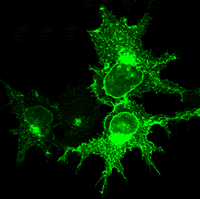Last updated: July 31, 2012
NHGRI Research Helps to Demystify Dyslexia
NHGRI Research Helps to Demystify Dyslexia
Dyslexia may be one of the world's most common learning disorders, but it is no common task to establish the genetic factors that underlie this complex condition. As part of this ongoing quest, researchers at the National Human Genome Research Institute (NHGRI), in collaboration with colleagues at the University of Oxford, in the United Kingdom, recently made a discovery that has opened a new window into dyslexia, as well as other common diseases caused by multiple genes.
At least one in 10 Americans has dyslexia, a brain-based disorder that can cause difficulty in reading and spelling. Both genetic and environmental factors are thought to contribute to the condition. Dyslexia tends to run in families, with the disorder affecting up to half of children born to parents with dyslexia.
While the DNA of any two people is well above 99 percent identical, the fraction of DNA that varies among individuals can play an important role in the risk of diseases. Researchers refer to these slight DNA differences as genetic variants.
Previous studies have found variants associated with dyslexia in or near a half dozen genes, including several that have been implicated in brain development. But researchers have been unable to pinpoint exactly how any of these variants act to disrupt the brain's normal development or function.
Now, in the March 27 edition of PLoS Genetics, a U.S.-British team that included researchers from NHGRI's Genome Technology Branch reports that it has identified a variant that can reduce production of a protein thought to play a key role in brain development. Scientists refer to genetic variants that affect the production of proteins and other biologically important molecules as "functional variants."
"This work provides the first strong evidence demonstrating the effect of a functional variant involved in dyslexia," said NHGRI Scientific Director Eric D. Green, M.D., Ph.D., a co-senior author of the study. "In addition to identifying a variant that may increase the risk for dyslexia, the approach we used in this study may pave the way to identifying elusive variants for cancer, heart disease and other common, complex disorders."
The research reflects a collaborative effort involving the laboratory of Anthony Monaco, M.D., Ph.D., at the University of Oxford and a group of NHGRI researchers led by Dr. Green. Together, these investigators focused on a region of human chromosome 6 near a gene called KIAA0319, which previous research indicated is important for proper development of areas of the brain involved in reading ability. Other studies also suggested that the gene may be involved in dyslexia, but no functional variants directly affecting the protein could be identified.
In this new study, the researchers looked at seven variants that did not lie within the KIAA0319 gene, which means the variants themselves did not code for a protein. Instead, such variants have the potential to influence the regulation of KIAA0319, indirectly affecting protein production by acting to turn the gene on or off. From this group of variants, the group zeroed in on one most strongly associated with dyslexia.
Specifically, they found that the genetic variant creates a new site where a regulatory protein called OCT-1 can bind to DNA. Previous work involving other genes had shown that when OCT-1 binds to DNA, it turns nearby genes off, preventing them from producing proteins. Scientists use the term "transcriptional regulatory elements" to refer to the DNA sites where proteins like OCT-1 bind.
"A functional variant can be very difficult to pinpoint, especially if it is located outside of the protein-coding regions of a gene," said the study's lead author Megan Dennis, a graduate student participating in the NIH Graduate Partnership Program at NHGRI and the University of Oxford. "This study is interesting and important because we are finally solving what is causing complex traits. Far into the future, our findings may prove helpful for diagnostic purposes and could potentially lead to genetic screens for dyslexia."
Besides the implications for dyslexia, researchers said their findings underscore the importance of looking beyond protein-coding regions and towards transcriptional regulatory elements in the search for genetic variants that influence the risk of common, complex disease. That will entail broadening the focus of many studies beyond the roughly 1.5 percent of the human genome that encodes proteins and into the vast realm of non-protein-coding DNA.
"As we found in this study, variants that are located outside of genes can be critically important in determining a person's risk of disease. It may sound overwhelming to expand our searches beyond genes, but we've shown that if you use a strategic approach, it can be done," said Dr. Green.
In addition to Dr. Green and Ms. Dennis, the authors of the PLoS Genetics paper included researchers from the National Cancer Institute (NCI) and the United Kingdom's University of Oxford and the Wellcome Trust Sanger Institute. The research was funded by the Wellcome Trust and the NHGRI and NCI intramural research programs.

